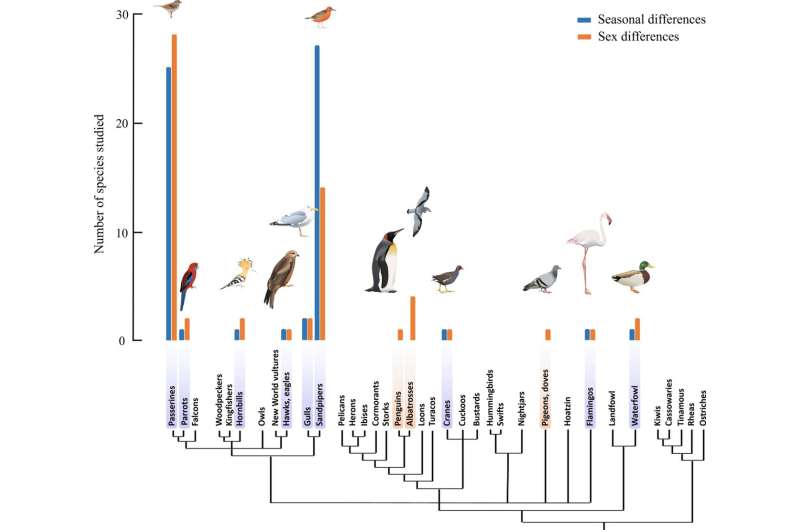Camouflage or communication: How birds use odor

What senses do birds use? Obviously, they use hearing and sight—after all, they sing and often have colorful plumage. But what about the sense of smell? For a long time, it was thought that olfaction played no role in birds. In recent years, however, a number of papers have emerged that refute this assumption—including research that looks at the secretion from the preen gland that birds smear on their feathers several times a day. Scientists, including some from Bielefeld University, have investigated what changes there might be in the composition of the secretion and what role smell plays in this. Their study was published on 6 February in the journal Biological Reviews.
Almost all bird species have a special gland at the base of their tail: the uropygial or preen gland. It secretes an oil that birds spread on their feathers several times a day using their beak. Some of the functions of the gland's secretion are to maintain the feathers, to make them greasy and water-repellent—and it could have other uses about which little is known so far.
The composition of this secretion differs not only between different bird species, but often also within a species itself. "One observation was pivotal for us: seasonal changes occur in almost all bird species," says Marc Gilles, a doctoral student in the Behavioral Ecology research group at Bielefeld University's Faculty of Biology.
Changes in preen oil during the breeding season
Together with other researchers, Gilles reviewed a total of 187 studies and analyzed 55 of them that investigate preen oil composition. "We wanted to find out why changes occur and what their significance is." The researchers detected sex differences in 47 percent of the species studied. "When we found differences between the sexes, they occurred mainly during the breeding season," says the biologist.
Camouflaging their offspring through smell
Why does the composition of the secretion change? "One hypothesis is that preen oil has a protective function during the breeding season," says Gilles. It could serve to camouflage a nest by smell and thus better protect it from those predators that use olfactory cues when hunting. This assumption is supported by the fact that differences can be found chiefly during the breeding season—and primarily in the incubating sex. Such seasonal differences were particularly evident in ground-nesting birds, such as shorebirds. "Ground-nesting birds are especially vulnerable to predators such as foxes, which hunt by using their sense of smell, because their nest is so easily accessible," says Gilles. "Olfactory camouflage here would mean higher chances of survival for the young."
Olfactory communication in reproduction
Another possibility is that preen oil in its altered composition has a social function: for example, the secretion could signal to a bird the sex of a conspecific—and whether it would be a suitable partner to reproduce with. The composition could therefore provide information about how genetically compatible two animals are to produce healthy offspring. "It is also conceivable that olfactory cues serve parent-offspring recognition," says Gilles.
"The findings indicate that existing studies support these hypotheses," says Professor Dr. Barbara Caspers, who supervised the study. She heads the Behavioral Ecology research group and has been investigating olfaction in songbirds for several years. In her studies, she was able to show that at least some birds have a well-developed sense of smell and actually use it to communicate with each other. The study, which has now been published, suggests that it may be a more general phenomenon. "However, unfortunately, there is currently not enough data to test the hypotheses further." The researchers have therefore made recommendations in order to improve the data situation.
There are not enough studies on the abilities of predators to recognize different compositions of the oil in order to test the assumption that an altered secretion serves as protection during the breeding season. Moreover, most studies so far have only revealed that there are differences between the sexes—but not the precise essence of these differences. "Additional information about the nature of the differences could help to separate the two hypotheses," says Caspers. Furthermore, it is not yet clear to what extent parents also transfer the secretion to their offspring. "More research is also needed on this," says Barbara Caspers. In many cases, it is also unclear in which breeding stages changes occur and whether birds are able to distinguish the sex of conspecifics by smell.
In the current study, the scientists point out what to look out for in future studies on preen gland oil. "In the studies we reviewed, it is rarely stated which gender shows changes. Moreover, it is seldom specified precisely what the changes are," says the scientist. If sex differences are of interest, researchers should take samples during the breeding season and also record the different breeding stages from pair formation to brood care. It would also be important to include more bird orders in the studies: for example, mainly shorebirds have been studied so far regarding the hypothesis on olfactory camouflage. "In this way, we would gain deeper insights into the role of chemical masking and chemical signaling in birds," says Caspers.
More information: Leanne A. Grieves et al, Olfactory camouflage and communication in birds, Biological Reviews (2022). DOI: 10.1111/brv.12837
Journal information: Behavioral Ecology , Biological Reviews
Provided by Bielefeld University



















